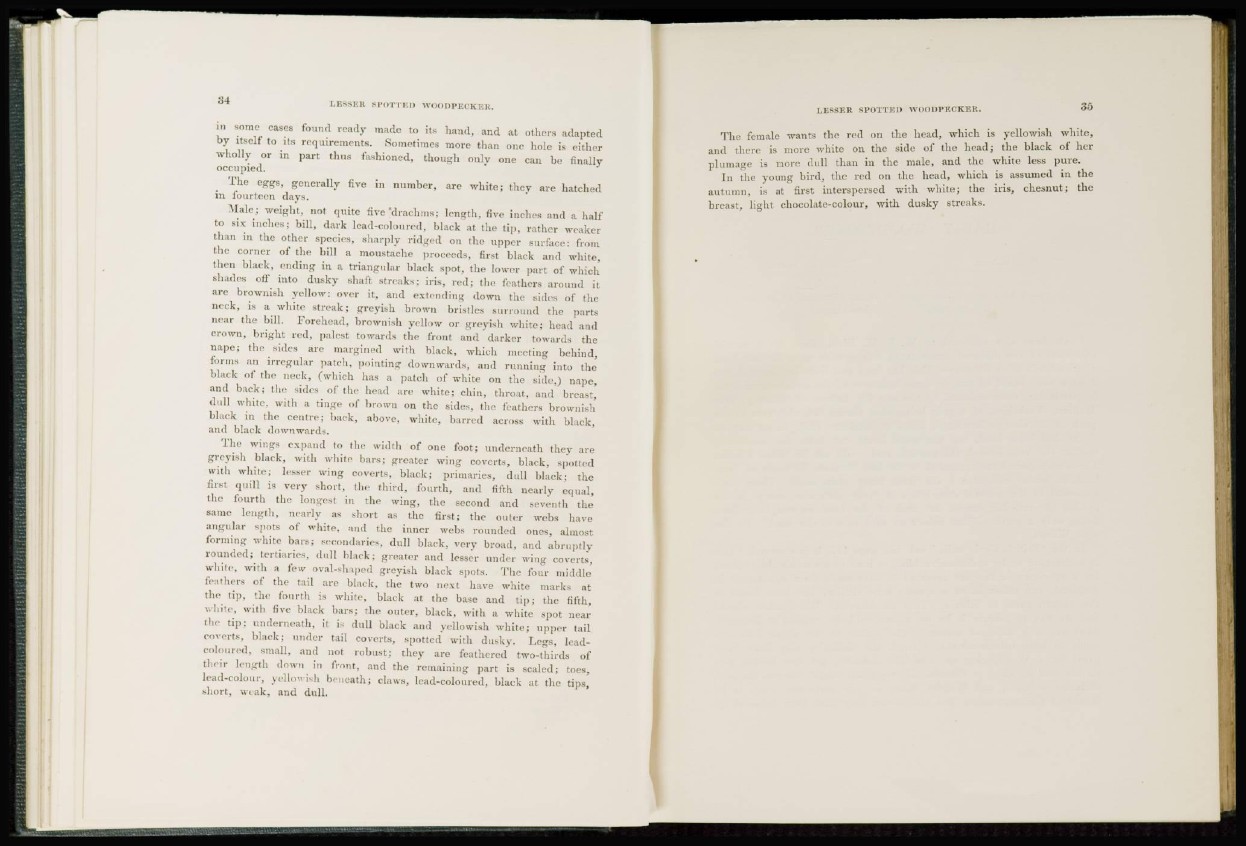
in some cases found ready made to its hand, and at others adapted
by itself to its requirements. Sometimes more than one hole is either
wholly or in part thus fashioned, though only one can be finally
occupied.
The eggs, generally five in number, are white; thev are hatched
in fourteen clays.
Male; weight, not quite five 'drachms; length, five inches and a half
to six inches; bill, dark lead-coloured, black at the tip, rather weaker
than in the other species, sharply ridged on the upper surface: from
the corner of the bill a moustache proceeds, first black and white,
then black, ending in a triangular black spot, the lower part of which
shades off into dusky shaft streaks; iris, red; the feathers around it
are brownish yellow: over it, and extending down the sides of the
neck, is a white streak; greyish brown bristles surround the parts
near the bill. Forehead, brownish yellow or greyish white; head and
crown, bright red, palest towards the front and darker towards the
nape; the sides are margined with black, which meeting behind,
forms an irregular patch, pointing downwards, and running into the
black of the neck, (which has a patch of white on the side,) nape,
and back: the sides of the head are white; chin, throat, ami breast,
dull white, with a tinge of brown on the sides, the feathers brownish
black in the centre; back, above, white, barred across with black,
and black downwards.
The wings expand to the width of one foot; underneath they are
greyish black, with white bars; greater wing coverts, black, spotted
with white; lesser wing coverts, black; primaries, dull black; the
first quill is very short, the third, fourth, and fifth nearly equal,
the fourth the longest in the wing, the second and seventh the
same length, nearly as short as the first; the outer webs have
angular spots of white, and the inner webs rounded ones, almost
forming white bars; secondaries, dull black, very broad, and abruptly
rounded; tertiaries, dull black; greater and lesser under wing coverts,
white, with a few oval-shaped greyish black spots. The four middle
lea'hers of the tail are black, the two next have white marks at
the tip, the fourth is white, black at the base and tip; the fifth,
white, with five black bars; the outer, black, with a white spot near
the tip: underneath, it is dull black and yellowish white; upper tail
coverts, black; under tail coverts, spotted with dusky. Tegs, leadcoloured,
small, and not robust; they are feathered two-thirds of
their length down in front, and the remaining part is scaled; toes,
lead-colour, yellowish beneath; claws, lead-coloured, black at the tips,
short, weak, and dull.
The female wants the red on the head, which is yellowish white,
and there is more wdiite on the side of the head; the black of her
plumage is more dull than in the male, and the white less pure.
In the young bird, the red on the head, which is assumed in the
autumn, is at first interspersed with white; the iris, chesnut; the
breast, light chocolate-colour, with dusky streaks.